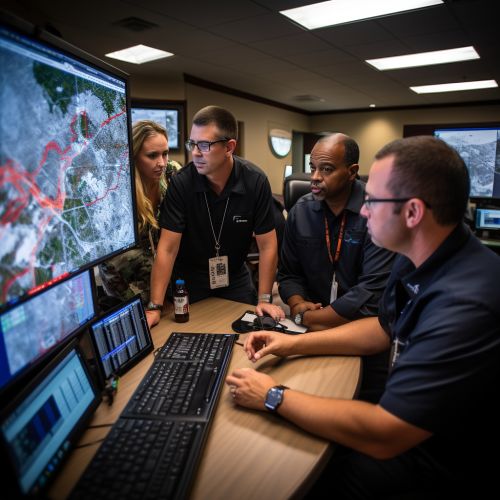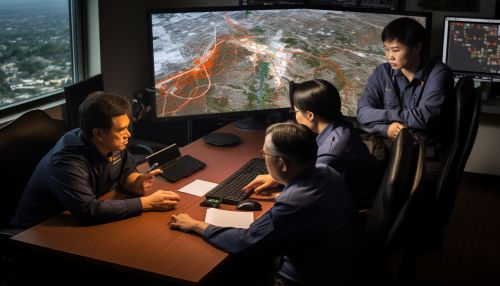GIS in Disaster Management
Introduction
Geographic Information Systems (GIS) have become an integral part of disaster management around the world. GIS technology allows for the collection, analysis, interpretation, and presentation of geographic data, which can be vital in predicting, preparing for, and responding to various types of disasters. This article delves into the role of GIS in disaster management, highlighting its applications, benefits, and challenges.


GIS and Disaster Management: An Overview
Disaster management involves the organization and management of resources and responsibilities for dealing with all aspects of emergencies, particularly natural disasters, man-made disasters, and complex emergencies. GIS technology plays a crucial role in each phase of disaster management: mitigation, preparedness, response, and recovery.
Mitigation
Mitigation involves efforts to reduce the impact of disasters. GIS can aid in mitigation by identifying areas at high risk of disasters. For example, floodplain mapping can help identify areas prone to flooding, and seismic hazard maps can indicate areas at risk of earthquakes. These maps can guide land use planning, infrastructure development, and other mitigation strategies.
Preparedness
Preparedness involves planning how to respond when a disaster occurs. GIS can support preparedness by providing tools for emergency planning and training. For example, emergency planners can use GIS to create evacuation routes, identify locations for emergency shelters, and estimate the potential impact of disasters.
Response
Response is the immediate reaction to a disaster. GIS can support response efforts by providing real-time data and situational awareness. For example, during a disaster, GIS can be used to track the disaster's progress, identify areas most affected, and prioritize response efforts.
Recovery
Recovery involves restoring the affected area to its previous state. GIS can support recovery efforts by helping to assess the damage and plan reconstruction efforts. For example, after a disaster, GIS can be used to map damaged infrastructure, identify areas in need of reconstruction, and monitor recovery progress.
Applications of GIS in Disaster Management
GIS has a wide range of applications in disaster management. These applications can be broadly categorized into three areas: natural disasters, man-made disasters, and complex emergencies.
Natural Disasters
GIS is extensively used in managing natural disasters such as earthquakes, floods, hurricanes, and wildfires. For example, in earthquake management, GIS can be used to map seismic activity, identify vulnerable structures, and plan evacuation routes. In flood management, GIS can be used to model flood scenarios, identify flood-prone areas, and plan flood mitigation measures.
Man-Made Disasters
GIS is also used in managing man-made disasters such as industrial accidents, nuclear incidents, and terrorist attacks. For example, in the event of a nuclear incident, GIS can be used to model the spread of radiation, identify affected areas, and plan evacuation and decontamination efforts.
Complex Emergencies
Complex emergencies refer to situations where multiple disasters occur simultaneously or in quick succession. In such situations, GIS can be used to integrate data from multiple sources, provide a comprehensive view of the situation, and support coordinated response efforts.
Benefits of GIS in Disaster Management
The use of GIS in disaster management offers several benefits. These include improved decision-making, enhanced communication, and increased efficiency.
Improved Decision-Making
GIS provides a visual representation of data, which can help decision-makers understand complex situations and make informed decisions. For example, during a disaster, GIS can provide real-time data on the disaster's progress, helping decision-makers prioritize response efforts.
Enhanced Communication
GIS can facilitate communication between different stakeholders involved in disaster management. For example, GIS maps can be shared with the public to inform them about the disaster and guide their actions. Similarly, GIS can be used to coordinate efforts between different response agencies.
Increased Efficiency
GIS can increase the efficiency of disaster management efforts by automating tasks and providing tools for analysis. For example, GIS can automate the process of mapping disaster-affected areas, freeing up resources for other tasks. Similarly, GIS tools can analyze data to identify patterns and trends, helping to predict and prepare for future disasters.
Challenges in Using GIS for Disaster Management
Despite its benefits, the use of GIS in disaster management also presents several challenges. These include data availability and quality, technical capacity, and ethical considerations.
Data Availability and Quality
The effectiveness of GIS in disaster management depends on the availability and quality of data. However, in many cases, relevant data may be lacking or of poor quality. For example, in developing countries, data on infrastructure and population may be outdated or inaccurate, limiting the effectiveness of GIS.
Technical Capacity
The use of GIS requires technical expertise in both GIS technology and disaster management. However, in many cases, there may be a lack of trained personnel to operate and maintain GIS systems. This can limit the effectiveness of GIS in disaster management.
Ethical Considerations
The use of GIS in disaster management also raises ethical considerations. For example, the collection and use of data in disaster management can raise issues of privacy and consent. Similarly, the use of GIS can lead to unequal access to information and resources, potentially exacerbating social inequalities.
Conclusion
GIS has become an indispensable tool in disaster management, offering a range of applications and benefits. However, the use of GIS also presents challenges that need to be addressed to maximize its effectiveness. As technology continues to advance, the role of GIS in disaster management is likely to become even more significant.
